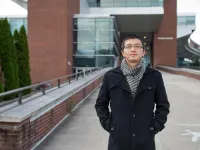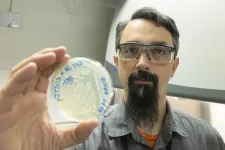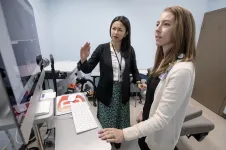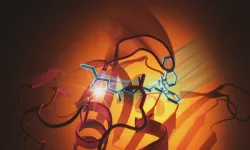(Press-News.org) UNIVERSITY PARK, Pa. — After a building failure due to natural disasters or poor structural design, safety inspectors must enter a structure to assess the damage before occupants can return. Researchers in the Penn State Department of Architectural Engineering studied how building inspectors make their safety assessments, by analyzing their gaze patterns with eye-tracking software. Eventually, the eye-tracking data could be used to code autonomous robots, like drones, to conduct building assessments in place of humans.
The researchers' results were published in Scientific Reports.
“We are looking for a way to capture how an inspector thinks and makes assessments on a building site to understand their intentions and diagnostic choices,” said corresponding author Rebecca Napolitano, assistant professor of architectural engineering. “Studying where they look, and for how long, at certain points on a building can help us do that.”
Researchers tasked 10 architectural engineering graduate students to assess two building facades while wearing Tobii eye-tracking glasses. The glasses have two cameras to measure movements and positioning simultaneously. One camera faces the object, and the other is trained on the user’s eyes to measure pupil dilation and gaze direction.
Study participants were given unlimited time to assess two sections of the facades of two steel-framed buildings in central Pennsylvania. Researchers chose the sites due to the buildings’ various observable issues, including plant growth, peeling paint, degrading bricks, cracks, water cooling and intrusion, and erosion at the foundation.
Participants — who all had some building diagnostics experience and received the same training ahead of the experiment on building inspection — spent varying amounts of time gazing at different points of the facades. Some missed more obvious issues and focused for long periods on smaller issues, such as cracks.
“Some of the issues were more or less obvious, and eventually everyone found most of the same things, but their approaches to the exercise were very different,” Napolitano said. “We learned that people, depending on their backgrounds, have biases when looking at structures.”
Someone accustomed to looking for certain issues, such as water damage, for example, will spend more time on that particular issue, Napolitano said.
The results differed from studies in other fields that have conducted eye-tracking assessments, such as in medical imaging research and psychology, according to the researchers. Experts in those fields were shown to spend the same amount of time on each point of a page, including when encountering abnormalities. The building inspection participants, on the other hand, tended to focus for longer periods on observable issues.
The broad differences in how people assess the buildings present a challenge for coding drones to perform the same inspections, the researchers said.
“It would be hard to take an average of all the data since the study participants had such different results,” Napolitano said. “But it is one small step in understanding how inspectors think, with the long-term goal of creating an algorithm to inform a drone.”
In the future, the researchers plan to carry out another eye-tracking experiment, this time using a 3D stimulus, such as a room inside of a building, as opposed to a building facade, which is considered 2D. Toward that goal, some members of Napolitano’s lab collected sample 3D eye-tracking data inside damaged structures during a visit to Mayfield, Kentucky, after the area’s December 2021 tornado, which the group intends to analyze and code.
“We plan to use the collected field data to create synthetic data, which we can then use to learn more about human-robot relationships,” Napolitano said.
In addition to Napolitano, the coauthors included Muhammad Rakeh Saleem, a Penn State doctoral student in architectural engineering, and Robert Mayne, a math instructor from Chariho Regional High School, Rhode Island, who assisted with the statistical analysis.
The National Science Foundation supported this work.
END
Eye-tracking during building inspections provides insight on how experts think
2023-03-28
ELSE PRESS RELEASES FROM THIS DATE:
New soil sensor may improve efficiency of crop fertilization
2023-03-28
UNIVERSITY PARK, Pa. — Measuring temperature and nitrogen levels in soil is important for agriculture systems but detecting them apart from one another is difficult to do. Huanyu “Larry” Cheng, James L. Henderson, Jr. Memorial Associate Professor of Engineering Science and Mechanics at Penn State, led researchers in the development of a multi-parameter sensor that can effectively decouple temperature and nitrogen signals so that each can be measured accurately. The results were recently published by Advanced Materials.
“For efficient fertilization, ...
Story tip: A wise tool for modifying microbes
2023-03-28
A DNA editing tool adapted by Oak Ridge National Laboratory scientists makes engineering microbes for everything from bioenergy production to plastics recycling easier and faster.
The Serine recombinase-Assisted Genome Engineering, or SAGE system, lets scientists quickly insert and test new DNA designs in a variety of microorganisms. Engineered microbes hold promise for making biofuels, recycling mixed plastics, aiding soil carbon storage and treating health disorders.
“SAGE works in virtually all microorganisms, revolutionizing what we’re able to do with microbes,” ...
Individualized brain fingerprints can help to uncover early signs of Alzheimer’s disease
2023-03-28
Neuroscientists from the Medical University of South Carolina (MUSC) report in Brain Connectivity that they have detected subtle differences in the way the brain functions in older adults with preclinical Alzheimer’s disease (AD).
Adults with preclinical AD have the earliest signs of disease, such as buildup of amyloid-beta proteins in their brains. However, they have no noticeable symptoms of cognitive decline.
The research team, led by Andreana Benitez, Ph.D., and Stephanie Fountain-Zaragoza, Ph.D., used a novel brain imaging analysis technique to construct individualized maps of brain function. They then looked to see if there were ...
Tax on sugary drinks helps health during pregnancy
2023-03-28
Taxes on sugary drinks reduce the risk of gestational diabetes and unhealthy weight gain in pregnant women, reports a new UC San Francisco study of more than 5 million women.
Published by the American Journal of Preventive Medicine, this is the first study to examine how sugar-sweetened beverage (SSB) taxes affect the health of mothers and children immediately before and after birth. Researchers compared mothers who were living in cities that had SSB taxes in effect while they were pregnant to mothers in cities with no SSB taxes. In addition to significantly lowering the risk of diabetes and unhealthy weight gain ...
Technology to protect bioactive compounds from food during digestion
2023-03-28
Bioactive compounds present mostly in fruit and vegetables perform different bodily functions relating to health and well-being. Their effects are considered antioxidant, antidiabetic, antiaging and anticancer, among others.
Many studies are looking for ways to optimize absorption of bioactive compounds by the organism and increase their bioavailability – the proportion that enters the bloodstream after absorption. One way is to coat the compounds with another material and package them on the nanometric scale (a nanometer is a billionth of a meter). Nanoencapsulation, as this technique is known, assures slow release of the compounds so that they take longer to digest and can survive ...
New drug combination holds unusually positive results for HPV-negative patients with advanced head and neck cancer
2023-03-28
WASHINGTON (March 28, 2023)— A new combination drug treatment showed promising results in patients with pan-refractory, recurrent/metastatic head and neck cancer, according to a study published today in the Journal of Clinical Oncology.
Head and neck cancer is a deadly form of cancer that arises in the lining of the mouth and throat. Worldwide more than 700,000 people were diagnosed with head and neck cancer in 2021. The disease is caused by the human papillomavirus (HPV) or environmental carcinogens, including the regular use of tobacco or alcohol. When the cancer comes back after curative ...
NASA wallops supports second rocket lab electron launch
2023-03-28
NASA’s Wallops Flight Facility supported the successful launch of a Rocket Lab Electron rocket at 6:39 p.m. EDT, Thursday, March 16, from Virginia’s Mid-Atlantic Regional Spaceport on Wallops Island, Virginia.
The mission, named “Stronger Together,” carried two, 100-kilogram commercial satellites to low-Earth orbit for Capella Space.
“I’m extremely proud of the NASA team that helped ensure a safe and successful launch operation today,” said ...
Researchers find new molecule that shows promise in slowing SARS-CoV-2
2023-03-28
Researchers have designed a molecule that slows the effects of one of SARS-CoV-2's more dangerous components – an enzyme called a protease that cuts off the immune system's communications and helps the virus replicate.
While much more needs to happen to develop a drug, scientists can begin to imagine what that drug could look like – thanks to new images of the molecule bound to the protease.
“We have been searching for an effective molecule like this one for a while,” said Suman Pokhrel, a Stanford University graduate student in chemical and systems biology and one of the paper’s lead authors. “It is ...
Rural educators find solutions to support multilingual learners
2023-03-28
A new study found a professional development program helped teachers in a rural school district in the Southeast to collaborate and identify innovative solutions to serve multilingual learners, or students learning English as a second language.
The study, published in the Journal of Research in Rural Education, suggests professional development can help prepare teachers in rural districts that have fewer resources and a growing need to support multilingual learners.
“Professional development is essential in rural communities, where you might not have resources for specialists like a literacy coach, bilingual school psychologist, or bilingual family engagement specialist,” ...
Retinal scans: A non-invasive, inexpensive method to track human aging
2023-03-28
Buck Institute professor Pankaj Kapahi thinks the eye is a window to aging. His lab, in collaboration with Google Health and Zuckerberg San Francisco General Hospital, has shown how imaging of the fundus, the blood vessel-rich tissue in the retina, can be used to track human aging, in a way that is noninvasive, less expensive and more accurate than other aging clocks that are currently available. Publishing in eLife, researchers also did a genome-wide association study (GWAS) to establish the genetic basis for such a clock, which they call eyeAge.
“This type of imaging could be really ...




